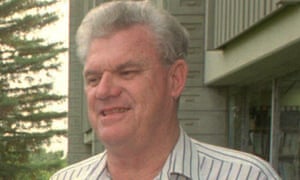Richard Taylor obituary
Scientist who shared the 1990 Nobel prize in physics for establishing that protons and neutrons are made up of quarks
Richard Taylor, who has died aged 88, won a share of the Nobel prize in physics for establishing that protons and neutrons are made up of quarks. His discovery, in the late 1960s with Jerome Friedman, Henry Kendall and a team of researchers, was a fundamental breakthrough in the understanding of the nature of matter, and encouraged a 50-year quest for the final link in the puzzle, the Higgs boson, which was found in 2012.
Taylor and his colleagues discovered quarks by building on the work of Ernest Rutherford, who, around 1910, had found that atoms have a nucleus – later shown to consist of protons and neutrons – but did not have the tools to probe any deeper. By contrast, Taylor was able to use a powerful accelerator of electrons at the Stanford Linear Accelerator Center (SLAC) in California to reveal the deep structure of first the proton and later the neutron.
Taylor’s experiment was arguably the moment when particle physics matured as “big science”. The discovery of the quark seeded the development of the Standard Model of particle physics and eventually, in 1990, led Taylor to be awarded the Nobel prize along with Friedman and Kendall.
He was born in Medicine Hat, Alberta, Canada, to Clarence and Delia (nee Brunswick) Taylor. As a child, Richard was good at mathematics and wanted to become a surgeon. He was also keen on chemistry and had a laboratory in the basement of his home, where an explosion led to the loss of a forefinger and parts of a middle finger and thumb. Told that people would not come to a surgeon without fingers, he gave up on his medical ambitions and turned fully to science.
At the University of Alberta in Edmonton he gained a degree, an MSc and met Rita Bonneau, a fellow student, whom he married in 1951. The couple soon moved to California, where Rita taught at a military school and Richard obtained a doctorate at Stanford University while working in its high-energy physics laboratory. He remained at Stanford until 1958, when he was invited to Paris for three years to help design experiments at a new accelerator at Orsay. He then spent a year at the Lawrence Berkeley National Laboratory in California before returning to Stanford to work at SLAC.
Low energy particles – to which Rutherford was restricted – deflect off the atomic nucleus as a whole; high-energy electrons, which SLAC provided, can penetrate something even as small as a proton. If the proton was a simple elementary particle, the lightweight electrons should bounce off with almost the same energy as they came in. A proton composed of a vibrant cluster of quarks, on the other hand, reflects the electrons very differently: an incoming electron might encounter a very energetic quark or merely a quiescent one. The result is that electrons bounce off the target with a range of energies through a spread of angles.
The idea that violent scattering of electrons could expose the presence of seeds within a proton sounds obvious in hindsight, but there was considerable scepticism about the concept at the time. A problem was that Taylor could only detect the scattered electrons; sceptics asked how one could tell whether the electron had indeed bounced off the target or had been knocked out of one of the target’s atoms – the electron from the beam, meanwhile, having escaped detection.
The sceptics had a point, for at that stage nobody anticipated that the proton would consist of hard seeds. Fortunately it does, and these give substantial kicks to the electrons, sometimes scattering them through large angles. The unexpected phenomenon called to mind Rutherford’s exclamation that “it was as if you had fired a 15-inch shell at a sheet of tissue paper and it came back and hit you”. By 1970 the accumulation of data convinced physicists that Taylor’s team was exposing something fundamentally new about the proton.
Despite the acclaim that came his way, Taylor was always modest about his role in the discovery of quarks. While he oversaw the design and construction of the experiment’s detector, as big as a two-storey house, which recorded the energy and trajectories of the scattered electrons, he stressed that “there were 20 of us named on that experiment” and that the team involved many more people. “There were around 40 of us who built that apparatus, backed up by another 40 engineers and technicians, using an accelerator that was built by a thousand people,” he said.
Following his breakthrough on quarks, Taylor continued to work on electron-scattering experiments for many years. He led a set of high-precision measurements in 1978 to look at how the scattering of electrons depends on the orientation of their intrinsic spin. This revealed that mirror symmetry is not perfect, and confirmed that the electromagnetic and weak forces are two manifestations of a single united “electroweak” force. This led to the 1979 Nobel prize in physics for Abdus Salam, Steven Weinberg and Sheldon Glashow, who had posited the existence of this unified theory.
Taylor was elected a fellow of the Royal Society in 1997 and was made a Companion of the Order of Canada in 2005.
He is survived by Rita and by their son, Ted.
• Richard Edward Taylor, physicist, born 2 November 1929; died 22 February 2018


No comments:
Post a Comment